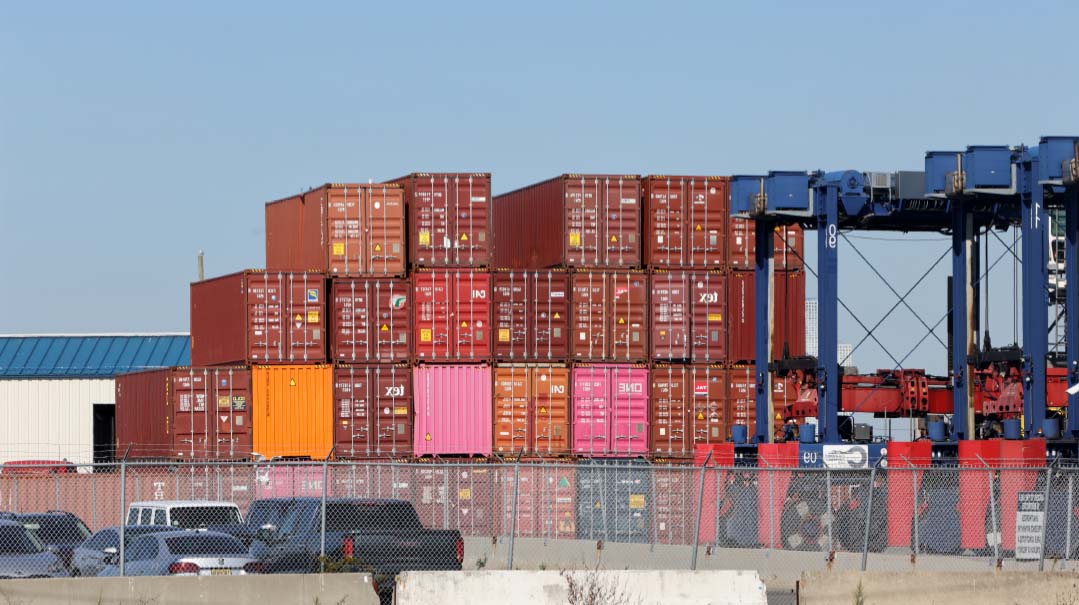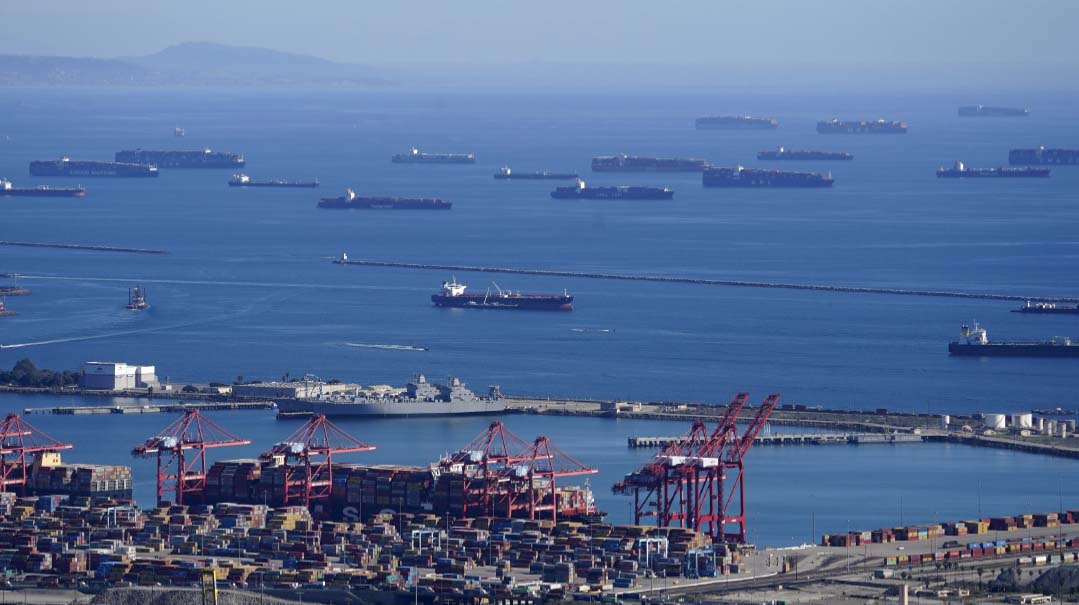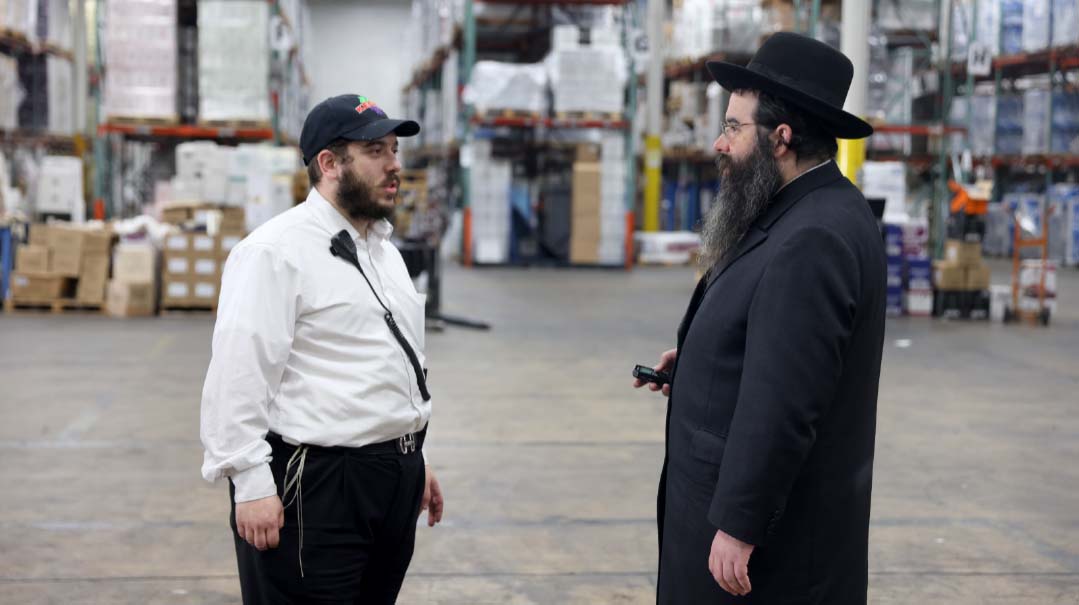Any Port in a Storm

A day at the docks exposes a supply chain left high and dry

Photos: Itzik Photography
The seagulls soaring overhead and the clanking of marine equipment testify to the proximity of the ocean — but for some reason, the air near the container shipping port in Bayonne, New Jersey, smells more like fuel than saltwater.
“You don’t really smell the seawater because it’s masked by the fuel produced by the glut of massive shipping containers around the port,” says Baruch Guzelgul, veteran sailor, trucker, and owner of Monsey One Trucking.
I watched as one large ship was being unloaded in the port. The freighter wasn’t exactly graceful, but it’s easy to be impressed by its giant size and the enormity of its load. The ship, marked with the letters CMA for the French carrier and the fourth-largest shipper in the world, was unloading 15,000 rusty yet colorful containers whose contents held anything from clothing for Macy’s and plastic bottles for Kedem to coins for Brinks and wood chips and steel to supply the East Coast’s growing housing demand.
A series of gigantic quay cranes reached out from under a conveyor, briskly transferring one container after the other from ship to shore. While the ship is nowhere near empty, a yard nearby is full of containers piled high, awaiting the fleets of trucks that will whisk them to their next destination. A second ship, identified by its white markings as coming from Israeli shipping giant ZIM, waited patiently under the distant Verrazano Bridge for its turn.
Things actually look calm and organized here, contrary to the scenes of backed-up container ships outside the ports on America’s West Coast. The delays, apparently, are coming only from other parts of the country. In New York and New Jersey, according to Amanda Kwan, the senior public information officer at the Port Authority, the ports had virtually no delays.
“As of this morning,” she told me, “we only have one ship waiting offshore, and on average for this year so far, waiting time is less than a day and a half. So we’re not experiencing the bottlenecks that you’re hearing about.”
The Bayonne port has a capacity of handling one big ship at a time, and it takes between one and two days to unload. It’s dwarfed by the one in Newark, which has six terminals and can service six ships at a time. The Port Authority also runs a port in nearby Staten Island.
“It takes about three weeks to come from China to New Jersey, and a day or two to unload,” Guzelgul said. “Until now, the longest a ship might have waited was two days in anchor. Now, they’re coming in and waiting for weeks. In Long Beach, you have over a hundred ships waiting in line and they can’t even get into the port.
“When I send a truck to the port,” he added, “in regular times it takes me two or three hours to begin loading. Now it can sometimes take me eight hours. Everything has a domino effect — the delays start from China, move on to the ports, comes to us, and then goes on to the stores and customers.”
But while Bayonne is calm and peaceful, that’s not the scene outside the ports of Los Angeles and Long Beach on America’s West Coast, in Savannah on the East Coast, or countless ports in China and across the commercial world.
The world is currently in the thrall of a giant snarl-up, the likes of which has never been seen. As of the end of last week, the port monitoring site Marine Exchange reported, there were 153 ships waiting in both California ports — in Los Angeles and Long Beach, the largest and second largest port in the country, respectively, which together handle 40 percent of America’s shipping — including 97 loitering, representing about 200,000 containers and carrying $24 billion in goods. The average wait time is ten days.
This is more than double the number of ships waiting just two weeks ago. If you calculate the amount of goods caught in this marine traffic jam, the cargo waiting along the Pacific coastline is the equivalent of six million cars, 150 million fridges, and a gut-punching 150 billion bananas.

Marine Mayhem
The backlogs that have hobbled ports around the world are caused by a delay in the global chain that supplies the products used by everyone, from housewives who make dinner to corporate plane manufacturers. The problems have been years in the making, but the Covid pandemic has brought its impact to the immediate fore. The crisis has been blamed, in part, on the worst inflation since the 2009 recession, and the extent of it has economists convinced it will not be going away that soon. Last week’s report showing a meager half a percentage growth for the third quarter of 2021 spooked economists. Some economists have blamed Covid’s Delta variant, but Jerome Powell, chairman of the Federal Reserve, attributed it to inflation caused by the bottlenecked supply chains.
It has also affected the man on the street in a personal way. One woman shopping in Rosner’s grocery in Brooklyn’s Kensington neighborhood said that she started noticing shortages a few weeks ago, so she stocked up on essentials. In particular, she bought out as many jars of Gefen hickory smoked barbecue sauce and Lieber’s sweet and sour duck sauce as were available.
“I went around to all the stores in Boro Park and bought out all the sauces,” said the woman, who asked not to be named. “The guy at the register asked me, ‘What are you doing with so many sauces?’ I told him that there will soon be a shortage of it and this is a staple in my household.’ And now you can’t find it anywhere.”
And that’s why the port-truck nexus at places like Bayonne find themselves at the heart of a global story suddenly concerning everyone from the White House to Boro Park homemakers. Just what has caused the sudden supply-chain crunch, what is there to do about it, and more crucially, how long will it last?
The current crisis can be blamed on glitches in the economy that have long been considered a runaway train in the making, the Covid pandemic, and actions by the Biden administration.
Countries and cities are basically run like homes. Look at the supply chain as you would your weekly grocery order. Well-run households have neat lists of how often to stock up on basics — milk and bread every three days, the Shabbos order every Thursday, plastic and paper goods must be ordered every month.
To keep storage at a minimum, stores like to purchase replenishments as late in the game as possible. This has led to just-in-time manufacturing, a system perfected in Japan and credited with allowing Toyota to become the number one carmaker in the world by keeping the number of vehicles in stock as low as possible. Rather than keeping large inventories of stock, companies rely on rapid replenishments from manufacturers when needed.
This has largely worked until now. Covid messed it up. Hugely.
When the pandemic first swooped down on the United States, tens of millions of people panicked and headed indoors. Commerce sputtered to a close, unemployment rolls shot up, and even regular grocery shopping slowed. In turn, companies that relied on buying and selling of goods were forced to lay off many workers. The US economy shrank by 3.5 percent in 2020, the worst since World War II. Even as the economy began humming again, people held off from big ticket purchases such as cars. Other disruptions included China shutting its ports twice, a shortage developed for the semiconductors which operate cars, and thousands of truckers who left their jobs because of Covid and opted not to return.
What happened was that millions of people are now ready to return to exercising their purchasing power, fueled by thousands of dollars gifted to them in three stimulus packages. E-commerce also jumped 25 percent in 2020 over the previous year, fueling an increasingly large demand for shipping. This was exacerbated by competition to get you the goods faster, with many promising same-day delivery.
The glut of goods ordered into the country, plus the shortage of shipping and container capacity was compounded, in turn, by a difficulty in getting truckers to transport their merchandises, said Yitzchok Lerner of Tristate Express, whose company mostly imports clothing from China.
America is currently 60,000 truckers short, while over the pond, Britain needs 100,000 truckers and the European continent has a shortfall of about 400,000 haulers.
“We get stuff from clothing wholesalers who get stuff from China,” he said. “So everything was backed up for months. It went from like $5,000 a container to about $20,000. Prices just skyrocketed in everything and that leads to shortages.”

Free Lunch
The city of Bayonne, in New Jersey’s north, is a quiet residential town with low crime and middle-class housing. The port, just a few blocks away, is a cauldron of activity, and further inland are a plethora of companies that rely on access to the port, including familiar brand names such as Ner Mitzvah, Chadad, Kedem, Kayco (which produces Gefen products), Star Snacks, and Guzelgul’s Monsey One Trucking.
Less than a week before the election between Democratic Governor Phil Murphy and his Republican challenger, Jack Ciattarelli, I passed dozens of Ciattarelli signs waving in the wind. But residents sitting on their porches seemed as unfazed by the whoosh of big rigs passing every few seconds as they were by the huge container ships pulling in every few hours.
“See all these trucks?” Gezulgul said, pointing to a sea of trucks zooming down Pulaski Street. “They’re all going to the port. They’re coming from the Turnpike.”
There’s no such thing as a free lunch, until you’re a trucker in the middle of a supply chain crisis. To induce truckers to join his fleet, Guzelgul is offering drivers a free lunch — barbeque chicken — just to listen to his pitch. A large sign outside his yard advertises a salary of $30 an hour, a nearly 50 percent bump over the prevailing wage of $18. Other trucking companies are trying to poach drivers by offering a raft of benefits.
Guzelgul is a pro at his job. “That’s an empty container,” he says, pointing at a truck that was speeding past us. “You hear the banging?” I didn’t, but it was obvious to him that this was a truck going to return an empty container to the port.

Shipshape to Shipwreck
The result of all these chain-reaction delays is not enough merchandise, a vastly more expensive supply line, and shortages in basic goods. The cost of shipping a 40-foot container from China hit a high of $22,000 last month, up from less than $2,000 two years ago. This Sunday, the cost was $20,115. Democrats say the delays are normal because more people have money due to President Biden’s stimuli, while Republicans have led #BareShelvesBiden to trend on social media, blaming his big-spend policies for the crisis.
One yeshivah administrator in Monsey says that when a school bus breaks down, he now has to wait months for it to be repaired. “I have one school bus now out of commission because a certain chip needs to be replaced,” he said, “and they say I can possibly wait a few months for it.” Some cars are no longer available for lease. Guzelgul himself says that he brought his leased car in for repairs two days earlier, and was told not to expect it back for at least five months. Observers of the consumer goods industry say to expect shortages of canned goods, toys and anything that needs plastic.
And the worst is yet to come, experts warn. The looming vaccine mandate for federal contractors, which includes delivery workers, will likely mean that a fifth of that workforce will be sidelined. As of this writing, President Biden has refused pleas to postpone the mandate to next year.
Biden’s assurance that everything will resolve itself in time for the upcoming holiday season was derided as impossible by those in the industry. They expect it to continue at least through the first half of 2022.
“I don’t think things will change soon,” Gezulgul said. “Everybody is still working now with the last backlog.”
The Kedem wine warehouse in Bayonne — a vast complex covering 187,000 square feet — is a good place to understand the next piece of the global puzzle: how companies experience supply chain failure.
According to Simchi Herzog — a member of the family that runs the iconic firm — bottle supplies were the first things to come under pressure. “The bottle manufacturers that we work with supply some of the biggest names in the industry. To deal with the supply chain crunch, they’re prioritizing those companies, but since we have a decades-old relationship with them, we haven’t been hit.”
But access to that supply, explains Herzog, comes at a cost. “In normal times, we don’t store excess quantities of supplies like bottles. But now a manufacturer will say to us, ‘Take a couple of months’ worth of supplies, because we don’t know if we’ll have any in a few weeks time.’ ”
In a market reliant on just-in-time supply chains, the reserves that Kedem builds up come at the expense of others who, by definition, won’t receive from suppliers — a local illustration of an economy-wide issue.
In the tale of haves and have-nots that the supply chain crisis has brought about, the need to suddenly store large quantities of basic manufacturing materiel means one thing: a scramble for extra facilities.
“Space is definitely a struggle” says Simchi Herzog. “But we’re lucky to be in a position to expand by hiring facilities around us.”
White House Calling
President Biden’s efforts to handle the shipping predicament has been limited to trying to move ships through the harbors and enticing former truckers to return to their jobs.
Over the past two weeks, Biden has announced agreements between a union and the ports of Los Angeles and Long Beach to begin operating around the clock. In addition, the ports voted on Friday to introduce steep fines for ships who idle at the docks — $100 per container per day. It noted that an estimated 40 percent of containers are left on the terminals for at least nine days, compared to fewer than four days a year ago.
Until a few decades ago, all ports operated 24 hours a day. But it became a day job following union pressure, and the unions have been reluctant to go back to that since their members would lose overtime pay.
The White House has also focused on trying to bring in a new supply of truckers by making it easier to get a commercial license. The White House says an average of 50,000 commercial driver’s licenses and learner’s permits have been issued each month this year, and far above 2020 levels.
The crunch could not come at a worse time for Biden, who is in the midst of trying to pass a bill that would pour trillions of dollars in additional spending on America. A central plank of the Democrat/Republican divide on financial policy is whether to make it easier to have access to money in order to increase employment or to make it harder in order for money to be worth more, taming inflation. But when inflation is here, prices go up and both parties have traditionally tightened the flow of funding.
Biden is of the traditional wing of the Democratic party. But he is under tremendous pressure by the socialist House Progressive Caucus and its 96 members to pass it anyhow. Nudged on by centrist Democratic Senators Joe Manchin and Kyrsten Sinema, he managed to whittle down a $3.5 trillion bill to half that size, but the supply chain delays have edged out the Afghanistan debacle as the cudgel Republicans are using to hammer him.
While the supply chain chokehold is caused by mistakes and chinks in the commercial chain that are years in the making, they’re hitting at the worst moment, just when Americans are emerging from a pandemic that practically felled the world economy.
“Whatever happens,” Guzelgul warned, “at the end of the day, all the charges are going to end up by the customer.” —
His Ship Came In
Istanbul-born Baruch Guzelgul moved to New York City in the 1970s and made a living as a car service driver, navigating the city’s gritty streets with boxes of food or fabric to deliver for stores. He soon tired of that career and headed out to the seas, working as a sailor for 22 years with ZIM, Israel’s shipping giant (whose name comes from Bilaam’s brachah, “v’tzim b’yad Kittim — huge fleets will come from the Kittim”). He returned to dry land and began trucking deliveries, starting off with two trucks and now owning a company of several dozen.
Similar to air traffic control towers, seaports are largely automated today. The process to gain entry to a terminal begins long before the ship arrives, and the communication goes on until it approaches the port and lays anchor. If there is a queue, as some ports have had in recent months, the ship might wait for days or weeks until it can be berthed. Ship operators loathe the long waits since costs can reach into tens of thousands of dollars a day, and because the salty seawater corrodes the vessels.
“We were always scraping the rust off the deck,” Guzelgul recalled of his time working as a sailor. “By the time we finished one end of the ship, we had to start again scraping the other end.”
(Originally featured in Mishpacha, Issue 884)
Oops! We could not locate your form.






